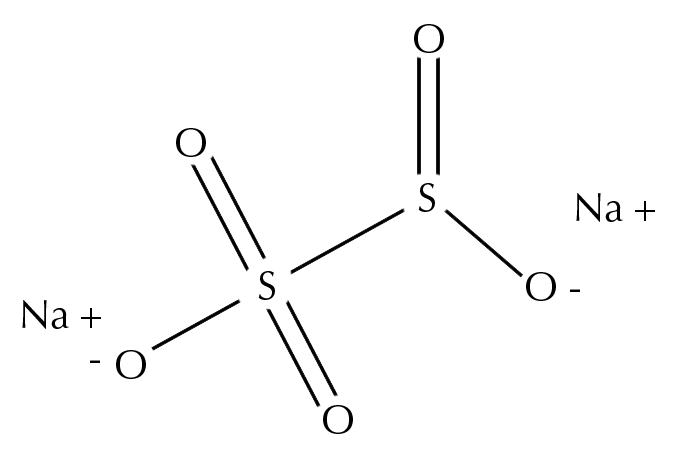What Is Sodium Metabisulfite?
Sodium metabisulfite is an antioxidant-based preservative that is used in cosmetics and skincare products to prevent contamination by bacteria and mold and to extend the shelf-life of products.
Antioxidants help to prevent oxidation of products which is a natural process that occurs when oxygen takes electrons from the ingredients in the formulation, changing their composition and efficacy. Oxidation often is associated with a change in the color and texture of a product. Antioxidants donate electrons to oxygen so that it doesn’t damage the formulation.
Additionally, sodium metabisulfite prevents the growth of bacteria and yeasts in a similar way, making it an effective preservative. Preservatives are important for the stability of your product and help to reduce contamination through use and from general environmental contamination from being open.
Sodium metabisulfite, also known as sodium pyrosulfite, is a white crystalline or powder solid with a slight sulfur odor. In addition to use in the cosmetic industry, sodium metabisulfite functions as a food preservative with the code E223. It is commonly used to stabilize wine or beer.
When added to these beverages, the sulfite compounds release sulfur dioxide gas, which prevents oxidation and also inhibits the growth of yeasts and fungi.
Additionally, sodium metabisulfite is used in the medical industry, in the oil and gas industry, and various other industries for different purposes. It also functions as a hair-waving/straightening agent.

Sodium Metabisulfite
the good: Helps to preserve your product, reducing contamination and extending its shelf life.
the not so good: Has been linked to allergy and sensitivity in some skin types.
Who is it for? All skin types except those that have an identified allergy to it.
Synergetic ingredients: Works well with most ingredients
Keep an eye on: Its other name, E223, which is what sodium metabisulfite is called when used as a food additive.
What Are The Benefits of Sodium Metabisulfite?
In cosmetics and personal care products, sodium metabisulfite functions as an antioxidant preservative and a hair-waving/straightening agent.
Preservative
As an antioxidant preservative, sodium metabisulfite works by protecting the other ingredients in a formulation from oxidation. Oxidation occurs when products are exposed to air. Oxidation changes the composition of some of the formulation’s ingredients such as fats and oils. Oxidation results in rancidity, color changes, viscosity changes, and deterioration of active ingredients in your skincare and bodycare products. Adding an antioxidant preservative like sodium metabisulfite will make the product less susceptible to degradation when exposed to environmental elements and prevent the growth of bacteria and molds.
Hair care
In addition to use as an antioxidant preservative, sodium metabisulfite functions as a hair-waving/straightening agent. It is often used in combination with sodium sulfite and sodium sulfate in products used to straighten the hair and in permanent waves. Other hair care products that use sodium sulfite include hair bleaches, hair dyes, colors and tints.
Is It Safe?
The United States Food and Drug Administration includes sodium metabisulfite on its list of substances considered Generally Recognized As Safe (GRAS) for use as a preservative in food. Sodium metabisulfite must be clearly labeled on the food packaging because some people are sensitive to sulfites.
The safety of sodium metabisulfite in skincare and cosmetic formulations has been assessed by the Cosmetic Ingredient Review Expert Panel. The Cosmetic Ingredient Review Expert Panel is a group responsible for evaluating the safety of cosmetic ingredients. Sodium metabisulfite has low dermal penetration which means it isn’t deeply absorbed into the skin however it has been linked to some irritation and allergy. After evaluating the available data, the Cosmetic Ingredient Review Expert Panel concluded that sodium metabisulfite was safe for its indicated uses in cosmetics and skincare products.
Despite the approval of sodium metabisulfite, it should be noted that a significant number of people are allergic to the group of ingredients known as sulfites, which includes sodium metabisulfite. Asthmatics and people with allergies to aspirin are at an elevated risk for this type of reaction to sulfites. Sodium metabisulfite can also be an irritant to the skin, eyes, and respiratory tract. With the occurrence of allergy in mind, sodium metabisulfite is used in low concentrations, posing little risk to your health.
References:
Cosmetic Ingredient Review, 2003. ‘Final Report on the Safety Assessment of Sodium Sulfite, Potassium Sulfite, Ammonium Sulfite, Sodium Bisulfite, Ammonium Bisulfite, Sodium Metabisulfite, and Potassium Metabisulfite’, International Journal of Toxicology, vol. 22, is. 2, pp. 63-88. Gavin, J, Parente, J & Goossens, A, 2012. ‘Allergic contact dermatitis caused by sodium metabisulfite: a challenging allergen. A case series and literature review’, Contact Dermatitis, vol. 67, is. 5, 260-269. Malik, M, Hegarty, M & Bourke, J, 2007. ‘Sodium metabisulfite – a marker for cosmetic allergy?, Cosmetic Dermatitis, vol. 56, is. 4, pp. 241-242.







